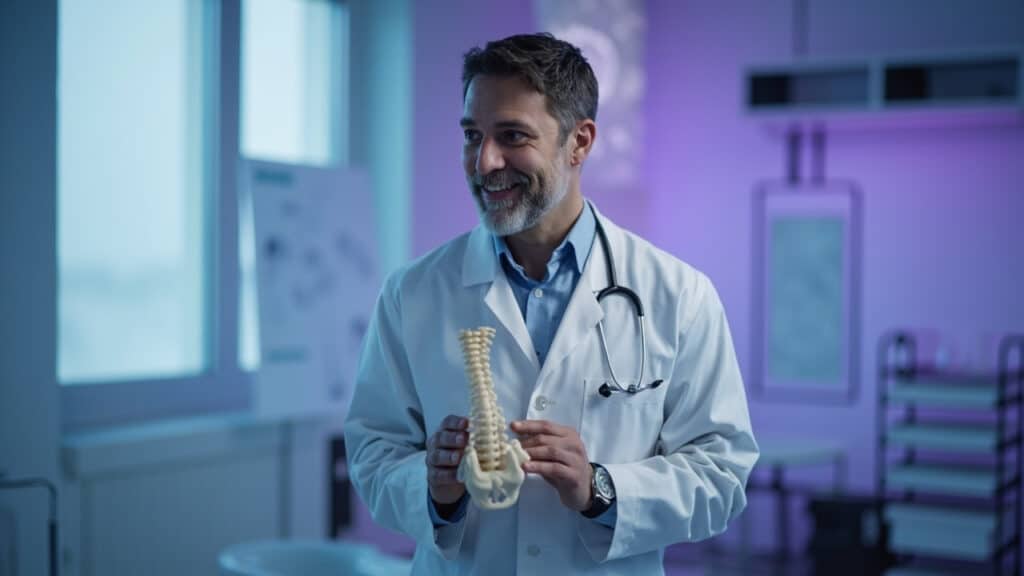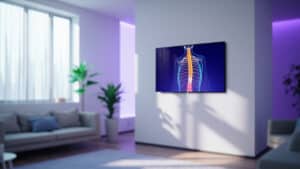Can A Herniated Disc Cause Hip Pain? An Evidence-Based Explanation
Written by Dr. Matthias Wiederholz, MD, Quadruple Board-Certified in Physical Medicine & Rehabilitation, Pain Medicine, Sports Medicine, and Regenerative Medicine
Quick Insights
Can A Herniated Disc Cause Hip Pain? A herniated disc—when soft disc material slips or bulges out—can compress nearby nerves, sometimes resulting in hip pain or weakness. Prompt physician assessment helps prevent lasting nerve damage and preserves mobility. Recent medical research supports this link in certain lower back disc levels.
Key Takeaways
- Research shows that L2-L4 disc herniation can lead to hip pain and muscle weakness in some people.
- Not all hip pain is from a herniated disc; thorough diagnosis by a spine expert is crucial.
- Hip pain triggered by back movements or radiating down the leg may indicate a spinal disc issue.
- Non-surgical treatments, like targeted regenerative procedures, can relieve hip pain from herniated discs and minimize downtime.
Why It Matters
Understanding if your hip pain is from a herniated disc empowers you to seek effective treatments, avoid unnecessary surgery, and protect your active lifestyle. Quick, accurate answers help relieve worry and support a faster return to the activities you love most.
Introduction
As a quadruple board-certified physician specializing in physical medicine, pain, sports, and regenerative care, I’ve helped thousands understand whether a herniated disc can cause hip pain. One leading-edge option for treating damaged discs is Discseel®, which provides a minimally invasive path to relief for many patients suffering from herniated disc hip pain, including those experiencing bulging disc and hip pain.
A herniated disc occurs when the soft, inner core of an intervertebral disc (called the nucleus pulposus) pushes out through its tougher outer layer (the annulus fibrosus), often irritating or compressing nearby nerves. What is herniated disc hip pain? It’s a unique pattern of discomfort—sometimes radiating from the lower back into the hip or even the inner thigh—that can threaten your mobility and daily activities.
Research confirms that certain lumbar discs, especially at the L2-L4 levels, can compress nerves linked to both back and hip pain—leading to muscle weakness, sensory changes, and functional loss in active people. Comprehensive analysis of nerve root involvement highlights the need for accurate diagnosis and timely, non-surgical interventions.
If you’re in Houston and hip pain is holding you back, you deserve answers and the right treatment—without unnecessary delays or surgery. Learn more about Dr. Matthias Wiederholz, MD, and his expertise in regenerative spine care.
Before exploring symptoms and treatments, you may want to understand how back pain can contribute to hip problems.
What is a Herniated Disc?
A herniated disc occurs when the soft center of a spinal disc (the nucleus pulposus) pushes through its tougher outer layer (the annulus fibrosus), usually because of an injury or progressive degeneration. When this displaced material compresses nearby nerves, it can trigger pain, tingling, numbness, or muscle weakness—sometimes in places that seem far from the spine.
Disc Anatomy Basics
Think of each disc in your spine as a jelly-filled cushion between bones (vertebrae). The disc’s strong outer ring (annulus fibrosus) can weaken or tear, allowing the soft inner core (nucleus pulposus) to bulge out, resulting in a herniation.
Clinical Observation Statement: In my practice, many patients are shocked to learn that small tears in their spinal discs—not always visible or symptomatic at first—can eventually progress to true herniations, sometimes after years of unnoticed degeneration. Recognizing subtle changes early can prevent bigger spine problems later on.
If you’re interested in learning about related disc issues, see my guide to spinal disc tears: causes, symptoms, and treatment options.
Common Causes
Factors that commonly lead to disc herniation include:
- Repetitive heavy lifting or frequent twisting motions (think warehouse jobs or moving furniture)
- Sudden injuries, such as slips or accidents
- Prolonged sitting, especially with poor posture or weak core muscles
- Age-related changes that reduce disc hydration and elasticity
Professional Assessment Phrase: As a quadruple board-certified regenerative medicine specialist, I’ve observed that underlying weaknesses—like poor ergonomics, genetic predisposition, or muscle imbalances—often set the stage for disc injuries, even in otherwise healthy, active people.
For more on herniated disc causes and management, visit herniated disc symptoms, causes, and treatment.
Can Herniated Discs Cause Hip Pain?
Yes, a herniated disc can cause hip pain when the bulging disc compresses nerves supplying the hip region—particularly at the L2-L4 spinal levels. Research confirms that L2-L4 nerve root compression can produce hip pain, weakness, or numbness radiating from the lower back toward the hip and thigh. Read more about lumbar disc herniation and nerve pathways.
Experience-Based Insight: Having personally performed over 10,000 regenerative spine procedures, I’ve seen many frustrated patients whose ‘hip’ pain was actually caused by a nerve root being pinched in their lower back. It’s not unusual for these individuals to try multiple hip treatments without relief until the true culprit—a disc herniation pressing on the right nerve—is diagnosed.
Nerve Pathways and Referral Patterns
The nerves at L2-L4 levels not only control muscles that flex the hip but also transmit sensation from the front and inner thigh regions. When these nerves are squeezed, pain signals may travel along their pathways—leading to discomfort in the hip, groin, or thigh, even though the real problem is in the lower back.
In my clinic, I’ve seen active patients—runners, cyclists, even yoga enthusiasts—completely surprised to discover their hip pain was actually part of a classic discogenic nerve referral pattern.
Curious if you may have a related issue? Everything you need to know about new treatments for ruptured discs breaks down current options in detail.
Research Evidence
Rigorous clinical studies have established that not all hip pain is disc-related, but lumbar disc herniation compressing the L2-L4 roots frequently produces hip-dominant symptoms and weakness. Clinical research underscores the value of connecting precise symptom patterns with nerve root involvement for accurate diagnosis.
Comparative Expertise: Unlike larger clinics, I personally walk each patient through their MRI and nerve patterns to ensure we’re not missing ‘silent’ disc injuries that could be causing unexplained hip pain.
Understanding Nerve, Joint, & Referred Pain
Pain from a herniated disc often stems from direct nerve compression, but confusing overlap exists—spinal nerves and hip joint sensory nerves share similar pathways, sometimes making it feel like your hip is injured when the disc is to blame.
On a cellular level, a herniated or degenerated disc can leak proinflammatory chemicals (like cytokines), amplifying nerve irritation and pain beyond just simple mechanical compression. Recent studies highlight the dual role of nerve inflammation and compression in generating both localized and referred pain.
Clinical Observation Statement: In my practice, distinguishing true nerve pain from referred pain is the foundation for treatment success. I see patients who’ve tried hip injections, only to find real relief when we precisely address the disc injury instead.
Proper diagnosis relies on blending detailed physical exams—testing which movements worsen pain or trigger nerve symptoms—with advanced imaging such as MRI and, when needed, targeted nerve testing.
Find out more about distinctions with symptoms of a bulging disc in the neck, C5-C6, and how different spinal levels may refer pain.
Symptoms: Disc vs. Hip Pain (How to Tell the Difference)
Differentiating herniated disc hip pain from hip joint pain is vital to choosing the right solution—and avoiding unnecessary surgery or missed treatment windows.
Disc-Related (Discogenic) Symptoms:
- Deep, aching pain that radiates from the lower back to the hip, thigh, or groin
- Numbness, tingling (“pins and needles”), or muscle weakness, especially in the front of the thigh
- Worsening with sitting, bending, coughing, or straining
Hip Joint Symptoms (NOT Disc-Related):
- Pain focused over the outer hip (side or buttock region)
- Stiffness or pain when rotating the hip joint
- Pain that does NOT worsen with spine movement or sitting
In my Houston and New Jersey clinics, many patients with disc-related hip pain describe a frustration that “nothing for my hip works”—until their true disc diagnosis is uncovered and addressed.
Professional Assessment Phrase: Matching the exact pain pattern, exam findings, and imaging is essential—something I prioritize so patients can finally get answers, not just guesswork.
If you’d like to learn more about associated symptoms, check out herniated disc pain in the hip and common warning signs.
When to Seek Medical Attention
If you experience:
- Sudden new weakness or numbness,
- Loss of bladder or bowel control,
- Severe, unmanageable pain,
Seek emergency evaluation—these signs indicate possible severe nerve compression needing urgent attention. Reference: Guidelines on nerve root symptoms and urgent indications.
Risk Factors & Diagnosis of Herniated Disc-Related Hip Pain
Certain risk factors increase your chances of developing hip pain from a herniated disc:
- Age over 30, especially with degenerative changes
- Heavy, repetitive lifting or frequent bending
- Long periods of sitting (desk jobs, driving)
- Poor posture and weak core muscles
- Family history of disc disease
- Physically demanding careers (e.g., construction, nursing, athletics)
Experience-Based Insight: I’ve found that ergonomic mistakes and lack of core strength are common contributors—even in my most athletic patients. In Houston’s active workforce and sports communities, I tailor prevention plans that emphasize spinal health, stretching, and body mechanics.
Want to know if your symptoms fit a disc diagnosis? Explore a comprehensive guide to L5-S1 bulging disc.
Diagnostic Tools (MRI, Clinical Exam)
An accurate diagnosis is rooted in a thorough clinical exam—testing muscle strength, reflexes, and nerve function—combined with imaging, usually MRI. MRI produces clear, detailed images of the discs, nerve roots, and surrounding tissue, helping pinpoint whether the disc or the hip joint is responsible. Learn more about MRI and pattern-based clinical exam correlation for diagnosis.
I always take time to correlate imaging results with real-world symptoms and physical findings—something that reduces unnecessary procedures and misdiagnosis.
Comparative Expertise: I personally review all imaging and exam findings with patients, unlike some larger clinics where you might not see the same provider twice. This ensures an individualized, precise diagnosis every time.
If you’re interested in related exams and treatment distinctions, see cervical herniated disc symptoms and treatment.
Treatment Options: Conservative, Traditional, and Regenerative Therapies
Most cases of hip pain from herniated discs get better without surgery—modern guidelines recommend starting with:
Conservative Care:
- Targeted physical therapy and core strengthening
- Non-steroidal anti-inflammatory medication (NSAIDs)
- Correcting posture and ergonomic stressors
- Activity modifications tailored to each patient’s activity level
Surgical Options:
- Minimally invasive microdiscectomy or laminectomy—reserved for cases with disabling symptoms or progressive nerve loss
- Surgery is not first-line; often considered only if weeks to months of conservative treatment fail
Evidence-based reviews show that surgery may provide only modest short-term benefits—and that complications or recurrent pain are risks to consider.
Why Regenerative?
Regenerative therapies—like Discseel®—use advanced, biologic techniques to heal the disc, reduce inflammation, and restore function naturally. These treatments address the root cause, not just the pain, and can often help patients return to work and activity faster.
Read more about the Discseel® Procedure and real patient reviews.
Clinical Observation Statement: In my experience, one of the greatest rewards is seeing a patient who thought surgery was their only option, rapidly regain their life through precise, targeted regenerative care—often with just a small Band-Aid and no hospital stay.
If you’re wondering about other options, visit the degenerative disc disease treatment options.
Spotlight: The Discseel® Procedure
The Discseel® Procedure is a minimally invasive treatment designed to seal and heal torn spinal discs using an FDA-approved fibrin biologic. This procedure aims to alleviate conditions such as chronic back and neck pain, sciatica, and radiculopathy by promoting the regrowth of healthy disc tissue.
Clinical studies have evaluated the Discseel® Procedure. One study with 827 participants over three years reported that about half experienced significant pain relief and less disability at a 12-month follow-up, with improvements maintained at 2 and 3 years. No severe adverse effects were noted during the study.
It’s important to note that while the fibrin biologic used in the Discseel® Procedure is FDA-approved, the specific application of this biologic for treating spinal disc issues is considered an off-label use. This means that, although the biologic itself has FDA approval for other indications, its use in the Discseel® Procedure has not been specifically approved by the FDA.
In summary, the Discseel® Procedure utilizes an FDA-approved fibrin biologic in an off-label capacity to treat torn spinal discs. Clinical studies have shown promising results in terms of pain relief and functional improvement, with a favorable safety profile.
How Discseel® Works
During Discseel®, I carefully guide a tiny needle into the damaged disc using advanced imaging, then inject a specialized fibrin sealant that binds the torn fibers and promotes collagen growth. This directly targets the root of pain and nerve irritation.
Professional Assessment Phrase: As a Master Instructor, trained directly by Discseel® inventor Dr. Kevin Pauza, I emphasize precision and patient comfort—every step is customized for your spinal anatomy and goals. Most patients resume gentle activities within days, with no hardware or overnight hospital stay required.
Benefits over Spinal Fusion
- No cutting, hardware, or general anesthesia
- Preserves the natural motion of your spine
- Rapid return to daily life, including work, sports, and travel
Experience-Based Insight: Having performed thousands of these procedures, I’ve witnessed transformations—from patients who could barely tie their shoes to those who return to golfing, cycling, or playing with their children pain-free—without invasive surgery.
Meet Dr. Matthias Wiederholz: Houston’s Leader in Spine Care
As the only quadruple board-certified regenerative spine specialist in the region—and one of only three Master Instructors for Discseel® worldwide—I offer unmatched, national-level expertise in non-surgical back and hip pain solutions. I was personally trained by Dr. Kevin Pauza and have performed over 10,000 minimally invasive spine and regenerative procedures.
Learn more about Dr. Wiederholz’s background and patient-centric philosophy.
Credentials & Recognition
- Board Certified: Physical Medicine & Rehabilitation, Pain Medicine, Sports Medicine, Anti-Aging/Regenerative & Functional Medicine
- Master Instructor for Discseel®, personally trained by the procedure inventor
- Nationally recognized for regenerative innovations, patient outcomes, and education
Comparative Expertise: Unlike larger academic or surgical spine centers, I’m personally involved in every step of care—from diagnostics through procedure and rehabilitation—ensuring your journey is compassionate, individualized, and seamless.
Practice Philosophy
My philosophy: Restore your spine, reclaim your life—without unnecessary surgery. My boutique, patient-centered practices in Houston and Lawrenceville provide advanced, minimally invasive solutions, tailored rehab plans, and ongoing support for your return to activity.
⭐️ Patient Review: Real Houston Experience ⭐️
“After years of getting nowhere with specialists and pain clinics, Dr. Wiederholz finally figured out my real issue—an L3 disc problem causing my ‘hip pain.’ The Discseel® procedure was life-changing. I was walking normal within a week. I can’t believe I waited so long!”
— Paul M., Houston
If you are interested in scheduling a consultation, visit our Contact Page now.
Patient Story: Real Results in Houston
Many people come to me after years of frustration, having cycled through hip treatments, medications, or even considering surgery without meaningful improvement. With a thorough diagnosis and targeted regenerative care, I’ve seen formerly sidelined athletes, busy parents, and professionals rapidly regain function and peace of mind.
Life After Discseel®: Patients frequently report returning to running, tennis, or simply enjoying time with family—without the shadow of chronic hip or back pain.
What Our Patients Say on Google
Patient experiences are at the heart of my approach to spine and hip pain. Every individual’s journey is unique, and I strive to ensure each patient feels heard, understood, and empowered throughout their care.
I recently received feedback that captures what we aim to provide in our Houston clinic. This reviewer shared their thoughts after working with me to understand and address their pain:
“My personal experience with Dr. Wiederholz – based on both appointments and other communications – has been fantastic. He seems to be determined to make sure you understand your own pain issues and treatment options. He will answer every question you may have, without making you feel like he is getting impatient. I highly recommend him, without reservation.”
— Paul
Hearing this kind of feedback reinforces my commitment to clear communication and patient-centered care—especially when helping people in Houston find answers for complex issues like herniated disc hip pain.
Herniated Disc Hip Pain Solutions in Houston, TX
Living in Houston means staying active—whether you’re working in a physically demanding job, enjoying the city’s vibrant sports scene, or simply keeping up with family. I see many Houstonians whose hip pain is actually rooted in a herniated disc, often overlooked due to the city’s fast-paced lifestyle and common occupational risks.
Houston’s diverse population and workforce face unique challenges, from long commutes to heavy lifting and repetitive movements. These factors can increase the risk of disc injuries that refer pain to the hip, making accurate diagnosis and targeted treatment especially important here.
At Performance Pain and Sports Medicine, I offer advanced, non-surgical solutions like the Discseel® Procedure right here in Houston. My goal is to help you return to your active life quickly and safely, without unnecessary surgery or downtime.
If you’re in Houston and struggling with hip pain that hasn’t responded to typical treatments, I encourage you to schedule a consultation. Let’s find out if a herniated disc is the true cause—and see if you’re a candidate for Discseel®. Contact us now.
Conclusion
Can a herniated disc cause hip pain? Absolutely—and recognizing this connection is the first step toward lasting relief. Many patients in Houston come to me after months or years of frustration, not realizing their hip pain is actually rooted in a disc problem. With advanced diagnostics and regenerative treatments, I help patients move beyond temporary fixes and reclaim the activities they love. Current clinical guidelines support non-surgical, regenerative approaches for disc-related pain, offering hope for those who want to avoid invasive surgery.
As a quadruple board-certified regenerative spine specialist, I am dedicated to providing advanced regenerative care without invasive surgery. My boutique practice ensures you receive personalized attention and rapid access to the most effective solutions. If you’re ready to stop missing out on life due to hip or back pain, I invite you to see if you are a candidate for the Discseel® Procedure. Contact our Houston office today and take the first step to reclaiming your health.
This article is for educational purposes only and should not be used as a substitute for professional medical advice, diagnosis, or treatment. Always seek the advice of your physician or other qualified healthcare provider with any questions you may have regarding a medical condition or treatment options. Never disregard professional medical advice or delay in seeking it because of something you have read in this article.
Frequently Asked Questions
Can a herniated disc cause hip pain?
Yes, a herniated disc can cause hip pain, especially when the disc compresses nerves at the L2-L4 levels. This often leads to pain radiating from the lower back into the hip or thigh, sometimes with numbness or weakness. Proper diagnosis is essential to distinguish disc-related hip pain from other causes and to guide effective treatment.
Where can I find non-surgical treatment for herniated disc hip pain in Houston?
You can find advanced, non-surgical treatments for herniated disc hip pain at my Houston practice. I offer regenerative options like the Discseel® Procedure, which targets the root cause of pain and helps patients return to daily activities quickly. Many Houstonians benefit from these minimally invasive solutions without the need for traditional surgery.
How do you determine if hip pain is from a herniated disc or the hip joint itself?
I use a combination of detailed physical exams, symptom pattern analysis, and high-resolution MRI to pinpoint the true source of pain. This approach allows me to distinguish between nerve-related pain from a herniated disc and pain originating in the hip joint, ensuring you receive the most effective, targeted treatment.
—
References:
1. Discseel® Procedure Overview
2. Clinical Study: Pauza Disc Treatment

















